A Private Tour today in North Norfolk. It was a lovely day, more like summer than spring – the weather seems to lurch from one extreme to another at the moment. Blue sky and up to 24C, with a still rather strong wind to start the morning easing off.
We headed up to NW Norfolk to start the day, in the hope of seeing some migration. As we walked in to Snettisham Coastal Park, there were lots of warblers singing – Blackcap, Chiffchaff, Sedge Warbler and then a Lesser Whitethroat rattling in the bushes. A Willow Warbler called and we saw it flitting around low in the hawthorns, possibly a fresh arrival back from Africa.
A Cetti’s Warbler shouted from somewhere deep in the reeds – good to hear as the population of Cetti’s Warbler here appears to have been hit quite hard by the winter weather. But there was no sign of the Ring Ouzel where it had been a couple of days ago – presumably some birds had moved on in the clear weather.
A few Mediterranean Gulls passed over heading south, in ones and twos. We could hear their strange nasal calls before we saw them. When they came overhead, we could see through their translucent white wing tips.
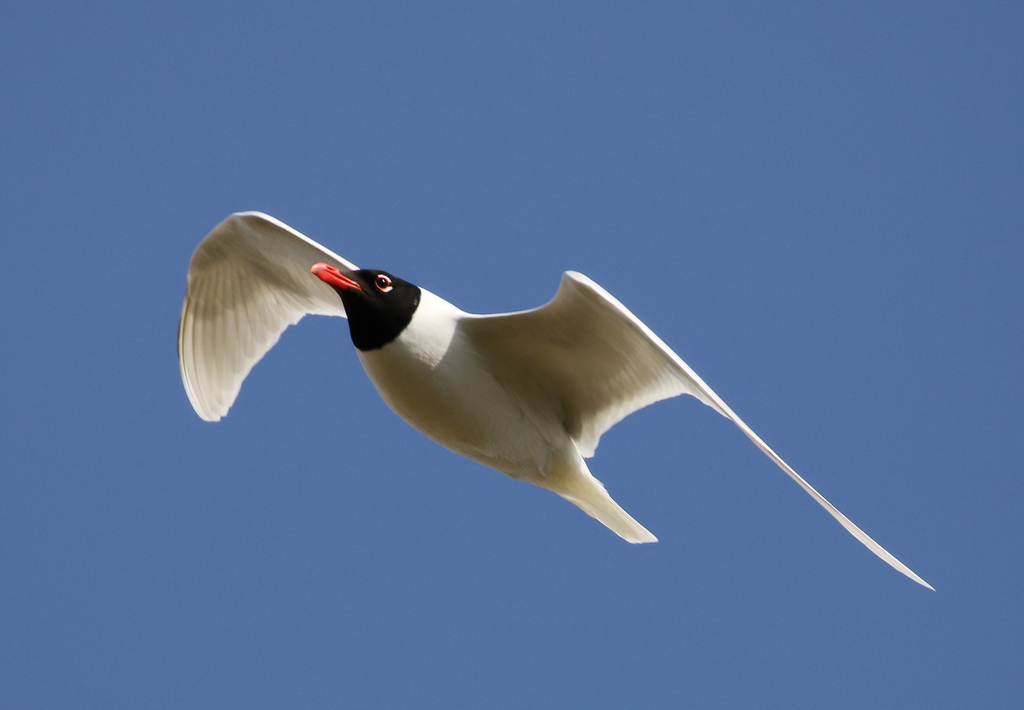
One of the locals told us there were some Wheatears on the clear area a bit further up so we walked over. There had been a male earlier, but we could only find two females now, flashing their white rumps as they flew up and away from us, feeding on the short grass.
A few birds had started to fly past along the seawall, migrating birds on their way to their breeding grounds. There was a steady trickle of Linnets, Goldfinches and Meadow Pipits. We heard the distinctive calls of redpolls as a small group passed overhead, but we couldn’t see enough of them to identify them to species.
A sharp ‘tchreep’ alerted us to a Yellow Wagtail flying past. It was nice and low so we could get a good look at it – a smart male, with bright yellow face and underparts. It was the first of several we would hear or see here moving along the coast this morning. However, there were no Swallows or Martins moving this morning, which we might have expected at this time of year and given the weather.
There were several more Lesser Whitethroats singing before we came across a single Common Whitethroat. We stopped to watch it, songflighting from the tops of the bushes. We could see its grey head, white throat, and rusty wing edges. The Lesser Whitethroats have already returned in good numbers but the Common Whitethroats are only now starting to arrive.
A pair of Stonechats appeared on the bushes on the seawall and flicked off ahead of us as we approached. Then we spotted a lark feeding quietly down in the short grass nearby. Even before we looked at it, it appeared to be rather short-tailed and through the scope we could see that it was a Woodlark. We could see its well-marked pale supercilium, short crest and distinctive black and white marked feathers on the bend of the wing.

Woodlarks nest not far from here, inland on the heaths, but they are not so regular down on the coast. This was most likely a migrant, stopping off here on its journey to feed and refuel.
The tide was high, so there wasn’t much to see out on the Wash this morning. Crossing over to the inner seawall, we scanned the grazing marshes and quickly located a large flock of Curlew roosting out in the long grass. Nearby, two slightly smaller, slimmer waders were busy feeding in the grass – two Whimbrel. Lots of Curlew spend the winter out on the Wash, but Whimbrel are just a spring migrant through here, so always nice to see at this time of year.
There were lots more warblers singing from the bushes as we walked back along the inner seawall. We had gone about halfway when we heard a distinctive reeling noise ahead of us – a Grasshopper Warbler. They have just started to return in the last few days, so we hurried towards where the sound appeared to be coming from. When we got there, we realised there were actually two Grasshopper Warblers singing against each other, presumably establishing a territorial boundary.
They were singing intermittently, but we eventually narrowed down the location of one of the Grasshopper Warblers to a large clump of brambles. Unfortunately, it didn’t want to show itself – it was still rather breezy and it was keeping well tucked down, unlike a Sedge Warbler which climbed up into the top of the same clump.
When we got back to the clear area where the Wheatears had been earlier, we found one of the females had been replaced by a smart male, with a bold black face mask. The Wheatears passing through here now are large, with richly marked burnt orange throat and breast, and a brown tinge to the grey of their upperparts. They are Greenland Wheatears, on their long journey from Africa most of the way across the Atlantic to Greenland to breed, an amazing feat for such a small bird.
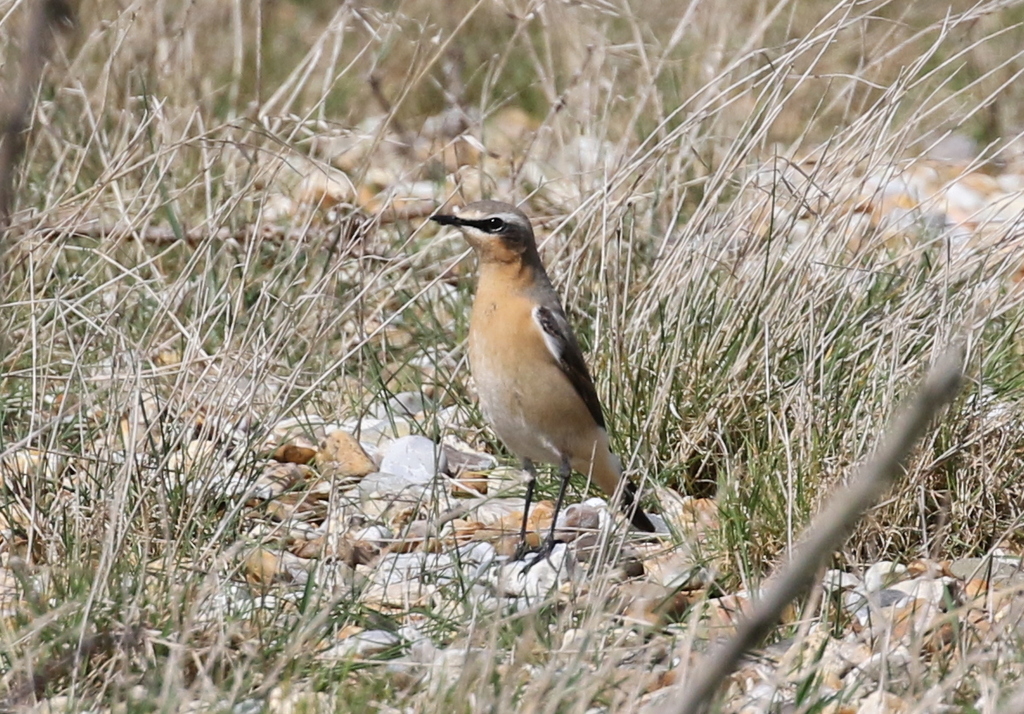
With a small amount of time before lunch, we decided to head inland next to Dersingham Bog, just a short distance away. As we drove back towards the main road, we noticed a Swallow flying round near the houses, surprisingly the first we had seen today. Presumably it was a breeding bird already returned, rather than a migrant.
As we walked down through the trees, we could hear a Nuthatch calling and found it high in the branches of an old oak tree. It flew across to a pine nearby and a Great Spotted Woodpecker appeared next to it. As we watched, we noticed the Great Spotted Woodpecker climbed up to a fresh hole in the tree, presumably where it is or is planning to nest.
The wind had dropped and, with the sun out, the temperature was really climbing now. Perhaps as a consequence, it was very quiet out in the open. A male Stonechat sang from the top of the heather and song-flighted, hovering in front of us, but there was no sign of any Tree Pipits now. As we got back into the trees, we could hear a Goldcrest high in the pines.
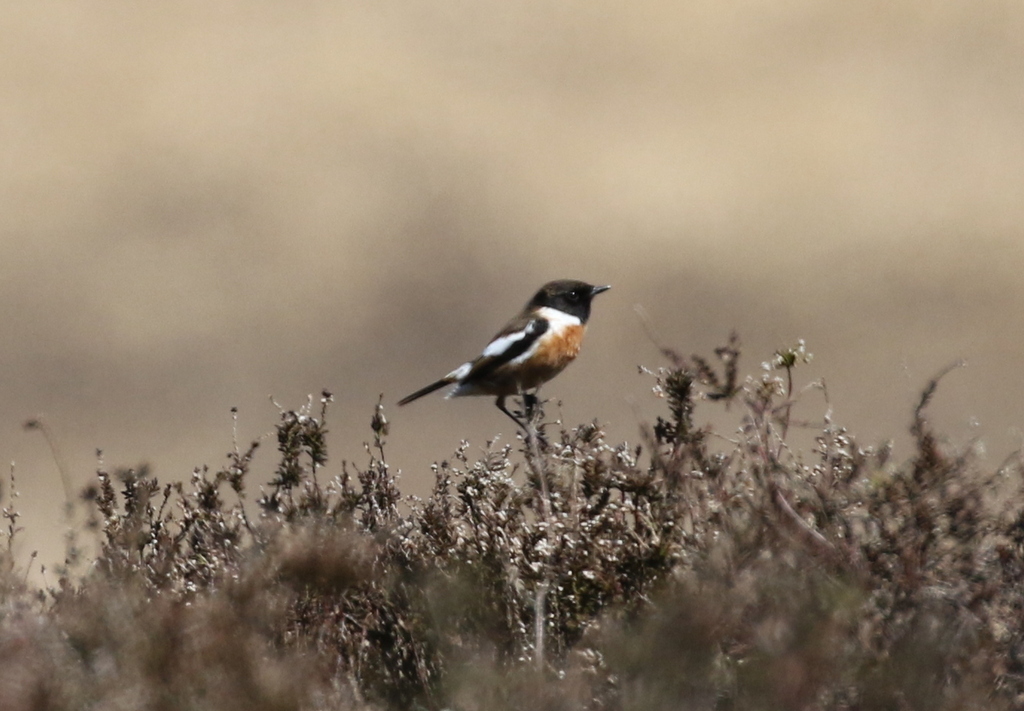
Lunch was eaten back at the car, joined by one of the other local birders who had just had a quick look out on the heath too. Then we headed over to Titchwell for the afternoon.
A quick look at the feeders in front of the visitor centre revealed a couple of Bramblings with the Chaffinches and Goldfinches. The Bramblings should be on their way back to Scandinavia soon. There was a report in the log of a Slavonian Grebe on Patsy’s Reedbed earlier, but no one in the visitor centre seemed to know anything about it. We decided to head round there first to check it out.
A single female Common Pochard was on the pool in front of Fen Hide, but there was no sign of any grebes on Patsy’s Reedbed. A small group of Black-headed Gulls was bathing out in the middle of the water, and one or two Mediterranean Gulls dropped in to join them briefly – looking very smart with their jet black hoods, white eyelids and bright red bills. A pair of Marsh Harriers were circling over the reedbed just beyond.
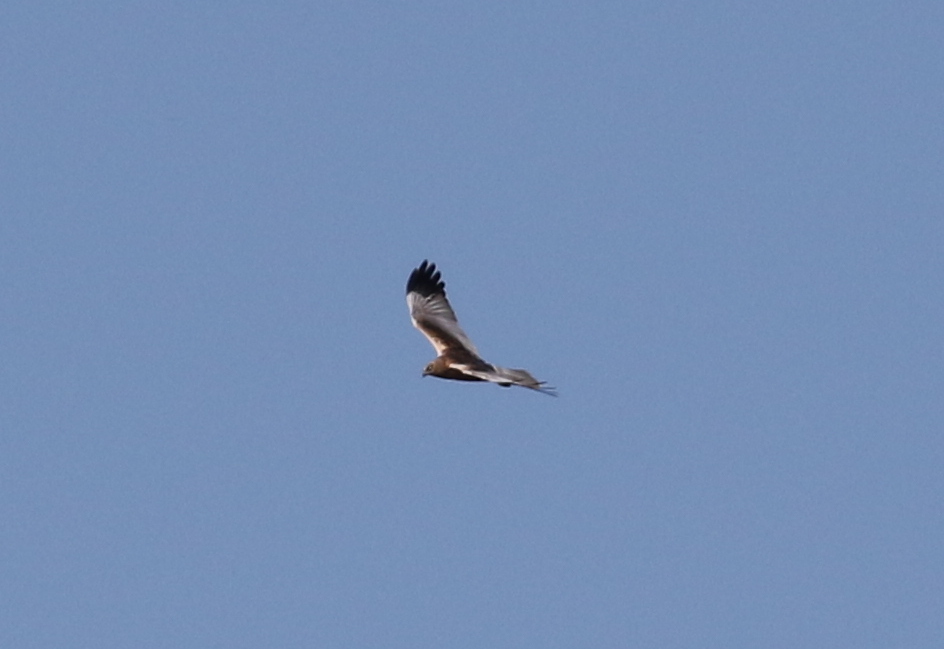
There was nothing in the paddocks today apart from a single Jackdaw – we had hoped there might be some wagtails stopping off to feed here – so we headed round via Meadow Trail and out onto the main part of the reserve.
The dried up ‘pool’ on Thornham grazing marsh looked empty at first too, as we scanned the puddles over towards the back. Then we realised the Little Ringed Plover was right down at the front, just beyond the reeds. We got it in the scope and could see its bright golden yellow eye ring.

The water level on the freshmarsh is looking great at the moment, but it is being rather dominated by the gulls which have taken over the fenced off ‘Avocet Island’. There were hundreds of Black-headed Gulls, with good numbers of Mediterranean Gulls in with them, plus a scattering of Common Gulls, Herring Gulls and a couple of Lesser Black-backed Gulls.
There was one Common Tern back yesterday, but the numbers had doubled today – there were two. They spent most of the time we were there asleep in amongst the Black-headed Gulls on one of the strips of mud.
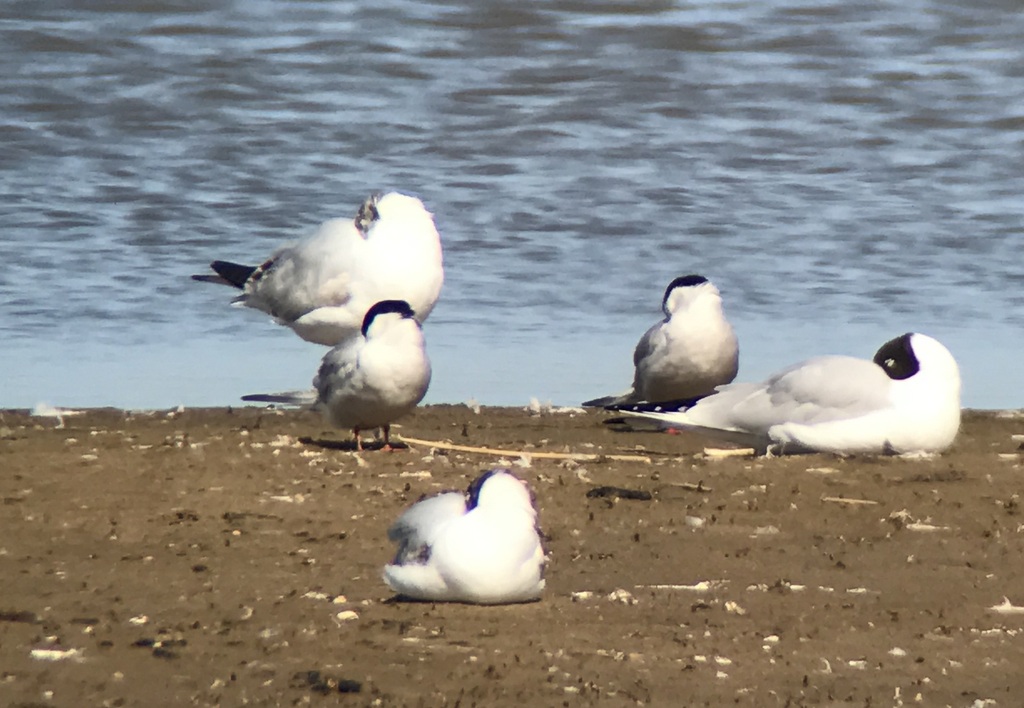
There were a few waders on the Freshmarsh. A scattering of Black-tailed Godwits included one or two birds already moulting into their smart rusty breeding plumage, ahead of the long journey back to Iceland to breed. There were a small number of Ruff and a couple of Redshank. Over beyond Parrinder Hide, we could see another Little Ringed Plover on one of the islands in the distance. There are a few Avocet on here too, but not as many as we might expect at this time of year.
Duck numbers are dwindling steadily, though there are still quite a few Teal here and several pairs of Shoveler. A good number of Brent Geese remain too, commuting between the saltmarsh out towards Thornham and the freshmarsh, where they fly in to bathe and preen. They should be leaving on their way back to Russia for the breeding season soon.
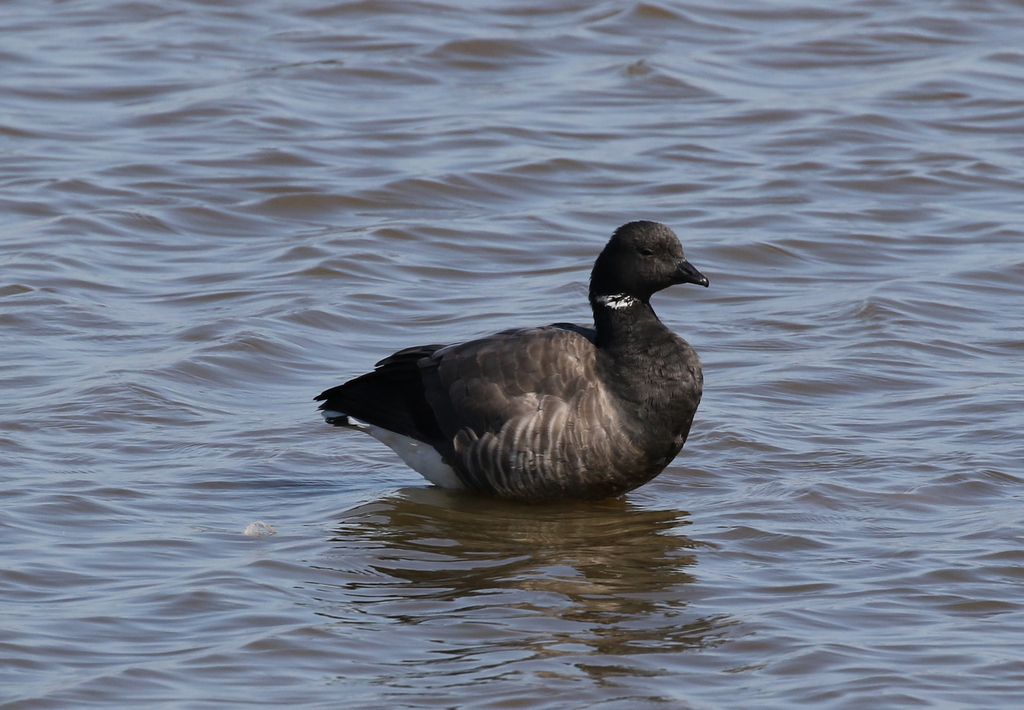
The Volunteer Marsh looked fairly quiet today – a few Redshank, a Curlew and a handful of Avocet feeding, plus several Shelduck. There were a few more waders in the channel at the far end, including a couple more Black-tailed Godwits. The Tidal Pools are still flooded, so we went straight on out to the beach.

The tide was out but there didn’t appear to be many waders out on the beach again today, apart from lots of Oystercatchers on the mussel beds. A lone Turnstone was feeding on there too. Scanning away to the west, we found a very distant couple of Bar-tailed Godwits and a few Curlew.
The only grebes we could find on the sea this afternoon were good numbers of Great Crested Grebes. Further out, we found a distant raft of Common Scoter and a couple of Red-breasted Merganser. Several Sandwich Terns were flying back and forth just offshore.
We made our way back to the car. As we passed the picnic area, we could hear a couple of Bramblings singing in the trees – although it can hardly be described as a song, more of a wheeze.
There had been a report of a Ring Ouzel in a field near Burnham Market, so we decided to try our luck there on our way back. There was no sign of it, but we did see a couple of pairs of Grey Partridge. A Red Kite circled lazily over. Then unfortunately it was time to call it a day and head for home.
















